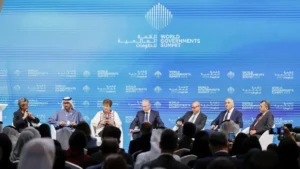A New World of Renewable Energy Beckons
2015 can be viewed as the year in which the epochal transition from one set of fuels to another took off, with renewables making such significant strides that, for the first time in centuries, the beginning of the end of the fossil fuel era has come into sight. Anthony DeLorenzo / CC BY 2.0
1
2
3
Anthony DeLorenzo / CC BY 2.0
1
2
3
While vast in their ambitions, these two schemes are not without their critics. Some environmentalists worry, for example, that Modi’s enthusiasm for the International Solar Alliance might actually be a public relations device aimed at deflecting criticism from his plans for increasing India’s reliance on coal to generate electricity. A report by Climate Action Tracker, an environmental watchdog group, noted, for instance, that “the absolute growth in [India’s] coal-powered electric generating capacity would be significantly larger than the absolute increase in renewable/non-fossil generation capacity” in that country between 2013 and 2030. “Ultimately, this would lead to a greater lock-in of carbon-intensive power infrastructure in India than appears necessary.”
The Gates initiative has come under criticism for favoring still-experimental “breakthrough” technologies over further improvements in here-and-now devices such as solar panels and wind turbines. For example, Joe Romm, a climate expert and former acting assistant secretary of energy, recently wrote at the website Climate Progress that “Gates has generally downplayed the amazing advances we’ve had in the keystone clean technologies,” such as wind and solar, while “investing in new nuclear power, geo-engineering technologies, and off-the-wall stuff.”
Despite such criticisms, the far-reaching implications and symbolic importance of these initiatives shouldn’t be dismissed. By funneling billions — and in the end undoubtedly trillions — of dollars into the development and deployment of green technologies, these politicians and plutocrats are ensuring that the shift from fossil fuels to renewables will gain further momentum with each passing year until it becomes unstoppable.
The Developing World Goes Green
In another sign of this epochal shift, ever more countries in the developing world — including some oil-producing ones — are embracing renewables as their preferred energy sources. According to the IEA, the newly industrialized countries, spearheaded by China and India, will spend $2.7 trillion on renewable-based power plants between 2015 and 2040, far more than the older industrialized nations.
This embrace of renewables by the developing world is especially significant given the way the major oil and gas companies — led by ExxonMobil and BP — have long argued that cheap fossil fuels provide these countries with the smoothest path to rapid economic development. Exxon CEO Rex Tillerson has even claimed that there is a “humanitarian imperative” to providing the developing world with cheap fossil fuels in order to save “millions and millions of lives.”
In accordance with this self-serving rhetoric, Exxon, BP, Royal Dutch Shell, and other energy giants have been madly expanding their oil and gas distribution networks in Asia, Africa, and other developing areas.
Increasingly, however, the targets of this push are rejecting fossil fuels in favor of renewables. Morocco, for example, has pledged to obtain 42% of its electricity from renewables by 2020, far more than planned by the members of the European Union. Later this month, the country will commence operations at the Ouarzazate solar thermal plant, a mammoth facility capable of supplying electricity to one million homes by relying on an array of revolving parabolic mirrors covering some 6,000 acres. These will concentrate the power of sunlight and use it to produce steam for electricity-generating turbines.
Elsewhere in Africa, authorities in Rwanda have commissioned a vast solar array at Agahozo-Shalom Youth Village, about 40 miles east of Kigali, the capital. Consisting of 28,360 computer-controlled solar panels, the array can generate 8.5 megawatts of electricity, or about 6% of Rwanda’s capacity. Spread over an undulating hill, the panels are laid out in the shape of the African continent and are meant to be symbolic of solar energy’s importance to that energy-starved continent. “We have plenty of sun,” said Twaha Twagirimana, the plant supervisor. “Some are living in remote areas where there is no energy. Solar will be the way forward for African countries.”
Even more significant, a number of major oil-producing countries have begun championing renewables, too. On November 28th, for example, Sheikh Mohammed bin Rashid, vice president and ruler of Dubai, launched the Dubai Clean Energy Strategy 2050, which aims to make the emirate a global center of green energy. According to present plans, 25% of Dubai’s energy will come from clean energy sources by 2030 and 75% by 2050. As part of this drive, solar panels will be made mandatory for all rooftops by 2030. “Our goal is to become the city with the smallest carbon footprint in the world by 2050,” Sheikh Mohammed said when announcing the initiative.
As part of its green energy drive, Dubai is constructing the Mohammed bin Rashid Al Maktoum Solar Park, intended to be the world’s largest solar facility. When completed, around 2030, the giant complex will produce some 5,000 megawatts of energy — about eight times as much as the Ouarzazate solar plant.
Long-Term Prospects
Evidence that an accelerating shift to renewables is already underway can also be found in recent studies of the global energy industry, most notably in the IEA’s just-released annual assessment of industry trends, World Energy Outlook 2015. “There are unmistakable signs that the much needed global energy transition is under way,” the report noted, with “60 cents of every dollar invested in new power plants to 2040 [to be] spent on renewable energy technologies.”
Your support matters…Independent journalism is under threat and overshadowed by heavily funded mainstream media.
You can help level the playing field. Become a member.
Your tax-deductible contribution keeps us digging beneath the headlines to give you thought-provoking, investigative reporting and analysis that unearths what's really happening- without compromise.
Give today to support our courageous, independent journalists.






You need to be a supporter to comment.
There are currently no responses to this article.
Be the first to respond.